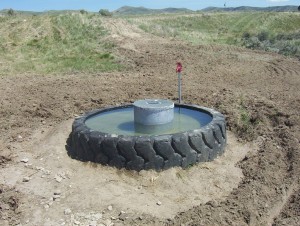
After 28 years of implementing conservation practices, the Farwell family has watched their marginal farmland transition into a cover of native and improved grasses that has reduced soil erosion and increased wildlife habitat.
As teenage boys Gary Farwell and his brothers Mike and Douglas jumped at the chance to help in the wheat and barley fields on their Idaho farm. As much as the family enjoyed farming and the agricultural way of life, Gary’s father and uncles, Max and William Farwell, were well aware of the challenges of consistently raising a crop on the marginal land which led them to enroll most of the family farm into the USDA Farm Service Agency (FSA) Conservation Reserve Program (CRP) 28 years ago.
“In the early years of our CRP enrollment it seemed like our values as farmers were up-ended,” said Farwell. “The beautiful green and golden colors of the summer crops were replaced by grass, shrubs, brush and weeds.”
However, during the past 28 years, Farwell and his brothers have realized the real value of their land is not in crop production, but in the environmental enhancements it is providing.
“From reduced soil erosion due to wind and water, the return of wild birds and game or simply a place where someone can drive down the road and find peace and beauty, these things are what makes the farm special today,” said Farwell. “CRP has helped us keep the farm in the family.”
CRP, which is celebrating its 30th anniversary in 2015, is among the largest private lands program for conservation used extensively throughout the United States to reduce soil erosion, improve water and air quality and provide wildlife habitat.
It is a voluntary program that allows eligible landowners to receive annual rental payments and cost-share assistance to establish long-term, resource-conserving covers on eligible farmland throughout the duration of their 10-to-15-year contracts.
Today, the Farwell’s have more than 2,800 acres enrolled in CRP in various mixes of native and introduced grasses, shrubs, forbs, and legumes as well as several pollinator habitat strips. The CRP practices are designed to help prevent soil loss from wind and water erosion due to the steep slopes of the land and help establish and enhance wildlife habitat.
“Having the land enrolled in CRP has done wonders to prevent and control erosion and the wildlife in the area are flourishing,” said Farwell.
Prior to CRP, the stubble wheat and barley fields were plowed in the spring using moldboard plows that bury plant residue and loosen the soil, then gone over again with a set of finishing discs and weeded every month to keep weeds down and an insulating dust layer while the ground built moisture for fall or spring seeding.
As part of their CRP participation, Farwell partnered with FSA and USDA’s Natural Resources Conservation Service (NRCS) to rehabilitate five old culinary wells located in choice areas to provide water for wildlife in seven water troughs. He also partnered with Idaho Fish and Game and FSA to plant and experiment with a variety of native trees, forbs and shrubs on the farm to nurture and enhance the return of native birds and big-game animals.
“My brother Mike has photographed elk, moose and even mountain lions at the watering troughs along with already common mule deer and upland game birds,” said Farwell. “Growing up we never saw moose or elk on the farm.”
According to Farwell, there is also an increase in partridge and sharp tail-grouse populations on the farm and he hopes to increase sage grouse populations going forward.
“CRP has helped our family improve the native habitat, give something back to the community and continually gives us satisfaction that we are leaving the land in much better shape than we found it,” said Farwell.
Last fall, Farwell and his family were presented with a certificate from the governor of Idaho recognizing the farm, “Sage Chicken Ranch” as an Idaho Century Farm; the first farm in Heglar to be recognized.
Since being established on December 23, 1985, CRP has helped prevent more than 8 billion tons of soil from eroding and protected more than 170,000 stream miles with riparian and grass buffers, more than 100,000 acres of bottomland hardwood trees, nearly 300,000 acres of flood-plain wetlands, and 250,000 acres each for duck nesting habitat and upland bird habitat.
2015 marks the 30th Anniversary of CRP. For an interactive tour of CRP success stories from across the U.S., please visit the FSA CRP 30th Anniversary website at http://www.fsa.usda.gov/CRPis30.






2 Responses to Idaho Century Farm Recognized for Outstanding Conservation Practices